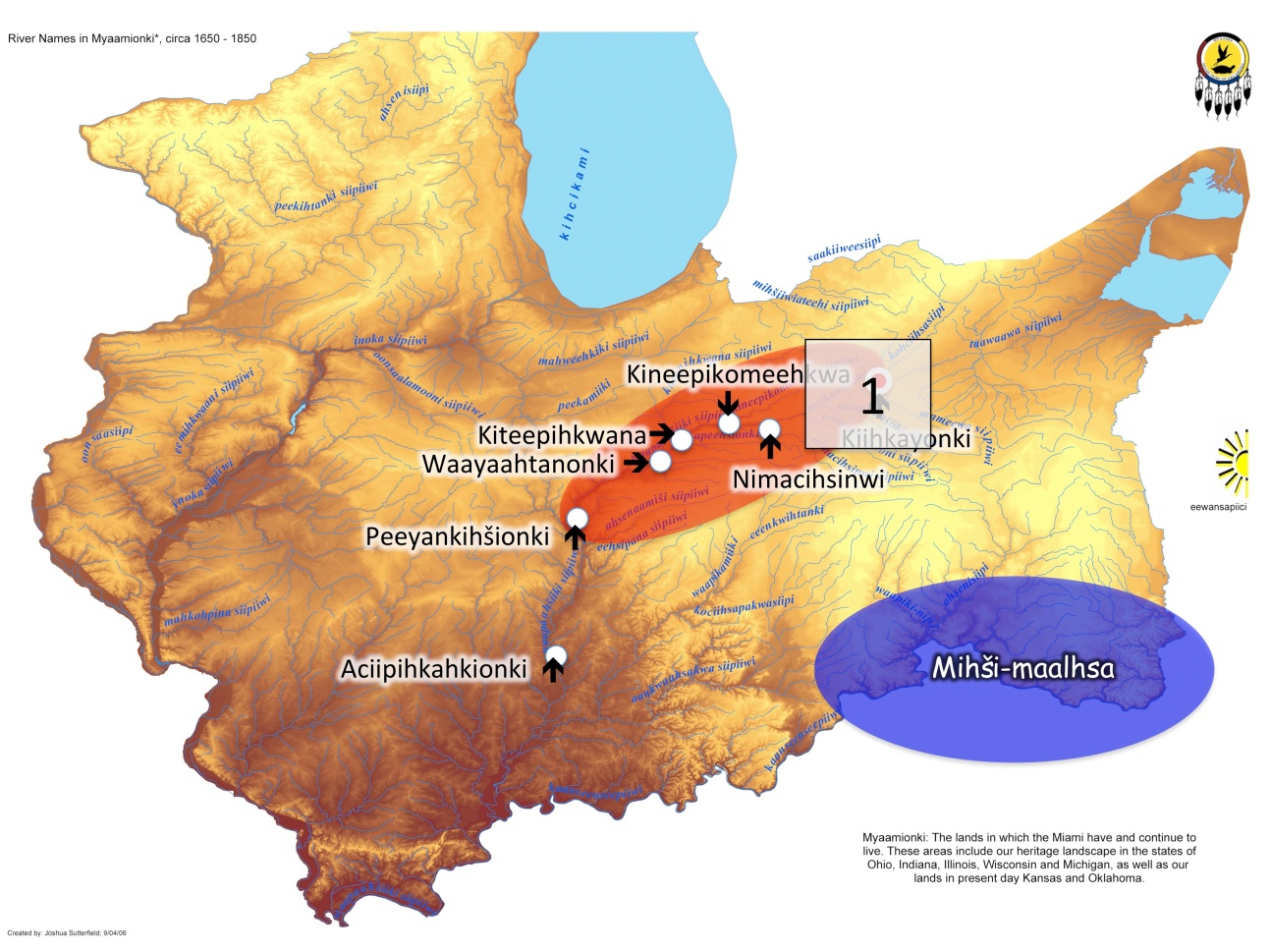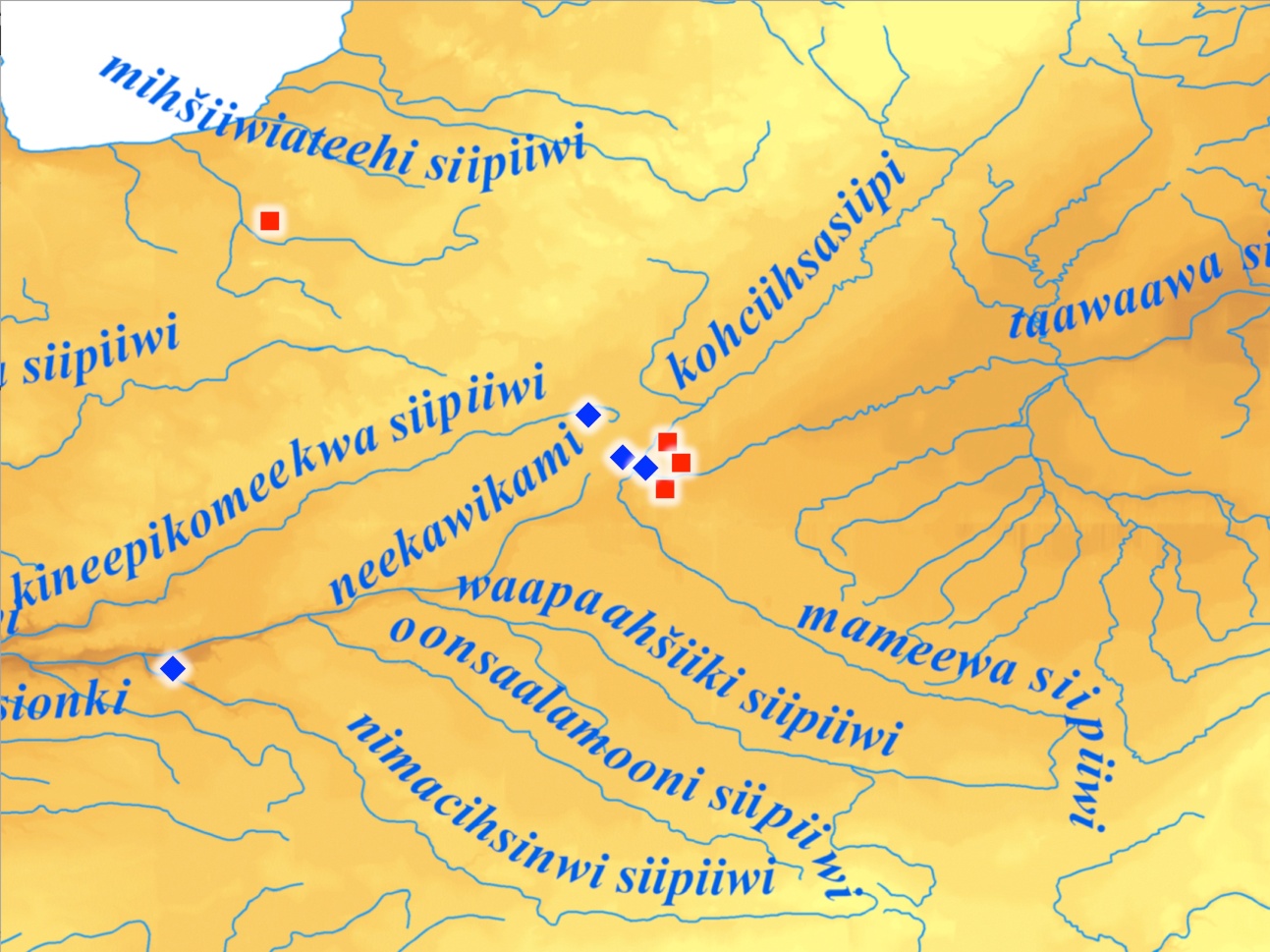March 31, 2014
meekaalankwiki mihši-maalhsa – mikaalitioni kiihkayonki
The Mihši-maalhsa Wars – Part II – The Battle of Kiihkayonki
The Mihši-maalhsa Wars – Part II – The Battle of Kiihkayonki
This article is the second of a five-part series on the history of our wars with the Mihši-maalhsaki (Americans), which occurred from 1778-1794 and from 1812-1814. This second article focuses on the Battle of Kiihkayonki, also known as Harmar’s Defeat. If you want to hear the pronunciation of the Myaamia terms in this article, please visit our online dictionary at: www.myaamiadictionary.org
In Part I of this series we looked at some of reasons behind the increased violence between Myaamia people and the Mihši-maalhsa (Americans) in the 1780s. When we left off, the Americans were desperately trying to assert the legitimacy of their claims to the Ohio River Valley in the Treaties of Ft. Stanwix (1784), Ft. McIntosh (1785), and Ft. Finney (1786). However, these treaties were largely viewed as fraudulent by Native peoples living along the Kaanseenseepiiwi (Ohio River), Taawaawa Siipiiwi (Maumee River), and Waapaahšiki Siipiiwi (Wabash River).
Following the defeat of La Balme (see last article), the Myaamia continued to raid American squatters along the Kaanseenseepiiwi (Ohio River). In response, the Mihši-maalhsa organized many raids on Myaamia, Delaware, and Shawnee villages throughout the region. This war of reprisals and retaliation forced Shawnee and Delaware villages to move ever farther north of the Kaanseenseepiiwi. Eventually, they were invited to build villages along the Taawaawa Siipiiwi, mostly to the west of the two Myaamia villages, which had been located there for generations (see the map below). The Myaamia village on the west bank of the Kociihsasiipi was the oldest and known by the name Kiihkayonki. Its twin across the river was usually called Miamitown or Le Gris Town, after it’s leading chief. However, because of the importance of Kiihkayonki, Myaamia people across time have tended to refer to the whole area around the confluence of the Taawaawa Siipiiwi as Kiihkayonki.[1]

This map of Myaamionki shows the position of many Myaamia villages around 1790. The area in shaded box marked 1 is shown with more detail in the map below. The blue “Mihši-maalhsa” oval represents the approximate area within which Americans were building settlements. Base map by Joshua Sutterfield, annotations by the author.

Inset map from shaded box marked 1 above. The three blue diamonds near the center of the map are, left to right, the Myaamia villages of the Kineepikwameekwa Siipiiwi (headwaters), Kiihkayonki, and Miamitown. The 3 red squares are, from top to bottom, an unnamed Delaware village, Chillicothe (Shawnee), and Piqua (Shawnee). The blue diamond in the west is the Nimacihsinwi village, and the red square in the northwest quadrant of the map is the Mihšiiwiateehi Siipiiwi village of Potawatomi and Myaamia, where most of the Kiihkayonki area Myaamia relocated at the beginning of Harmar’s attack.
By the late 1780s, a large contingent of Myaamia, Delaware, and Shawnee were living along the Taawaawa Siipiiwi and its feeder streams. For this reason, I’ll be referring to these allied peoples as the Taawaawa Siipiiwi villages (the Maumee River villages). On the last day of the Battle of Kiihkayonki, Potawatomi, Sauk, Meskwaki, and Ottawa men joined in the fight against the Mihši-maalhsa. However, the bulk of the men defending Kiihkayonki throughout the nine days of the battle were from the Myaamia, Shawnee, and Delaware villages on the Taawaawa Siipiiwi.
In this same period of time, the Congress of the United States passed the Northwest Ordinance (July of 1787). It is not clear if the people of the Taawaawa Siipiiwi were aware of this legislation. This ordinance laid out the young country’s long-term plans for the lands north of the Ohio. The U.S. claim to this land was based on the continued fiction that the British owned these lands and passed control to the Americans at the Treaty of Paris. President George Washington appointed Arthur St. Clair to be the first Governor of the Northwest Territory. From the American point of view, this territory included all the land that would eventually become the states of Ohio, Indiana, Illinois, Michigan, Wisconsin, and a part of Minnesota. The perspective of the 1000’s of villages, located throughout this immense area, was decidedly different. In their view, these lands belonged to the people who lived on them.[2]
One of the most common myths perpetrated about indigenous Americans is that we had no sense of land ownership prior to European arrival. This falsehood is partly a product of the “noble savage” stereotype that paints us all as living in balance with nature and leaving no mark on the land. It is also a result of the perverse logic of the right of conquest, which argued that non-Christians had no legitimate legal claim to their homelands. The reality was quite different. For example, our Myaamia ancestors shaped their environment quite powerfully through the use of cultural fire. They regularly burned the prairies and forests throughout their homeland in order to produce the kind of environment they preferred. They also had a firm sense of control over the lands they shaped. Village sites and their surroundings were deemed under the control of the people of that village. Other groups could only move nearby at the invitation of the more established community. Over time, some river valleys and regions became associated with particular groups to such a strong level that an invitation was required even when a site was unoccupied. The most prominent example of this was when the Myaamia invited the Delaware to move to the Waapikamiiki (White River in Indiana) in the 1790s.[3]
It is true that Myaamia understandings of ownership were different from Europeans. Myaamia ownership was collective rather than based on the individual. Myaamia ownership was also based on use and physical control rather than abstract legal documentation and courtroom procedures. However, Myaamia people very quickly learned to understand European conceptions of land ownership. They knew full well what the Americans were demanding at the farcical treaties they negotiated in 1784, 1785, and 1786. When the newly appointed Governor of the Northwest Territory put out the call for another treaty in 1788, the Myaamia and other peoples fully resisted attending.[4]
From 1786 through 1788, the Myaamia, Shawnee, Delaware, and others were adamant that the Kaanseenseepiiwi (Ohio River) should be the boundary between the Mihši-maalhsa and the indigenous peoples living north of the river. Over and over again they repeated that there would be no new cession of land north of the Kaanseenseepiiwi. The only exception they offered was a willingness to consider the previous session of lands east of the Muskingum River, in the southeast corner of what would become the state of Ohio. This one concession was offered only if the Mihši-maalhsa would stop all other settlement north of the Kaanseenseepiiwi.[5]
In the winter of 1788, Governor Arthur St. Clair attempted to negotiate yet another treaty at Fort Harmar, at the confluence of the Muskingum River with the Kaanseenseepiiwi (Ohio River). This site is near today’s Marietta, Ohio (see image below). Leaders from the Myaamia villages and from their allies among the Shawnee and Delaware refused to attend. St. Clair and Secretary of War Henry Knox eventually used their failure to attend as a part of the justification for attacking their villages on the Taawaawa Siipiiwi.[6]
